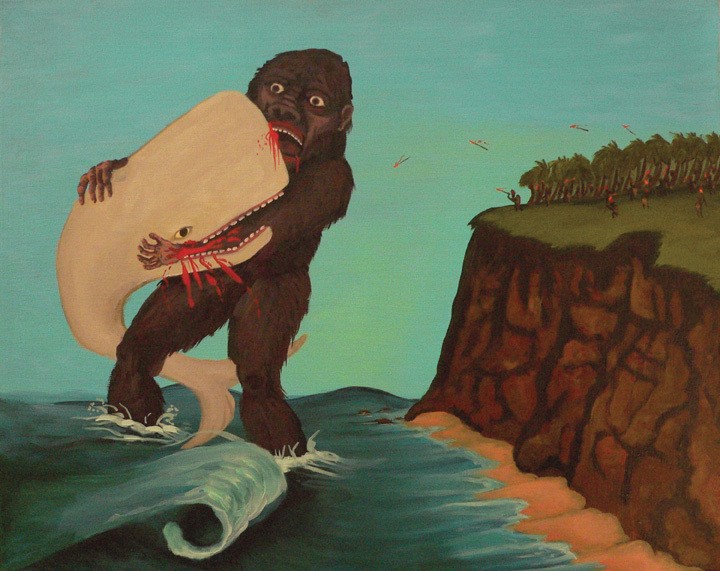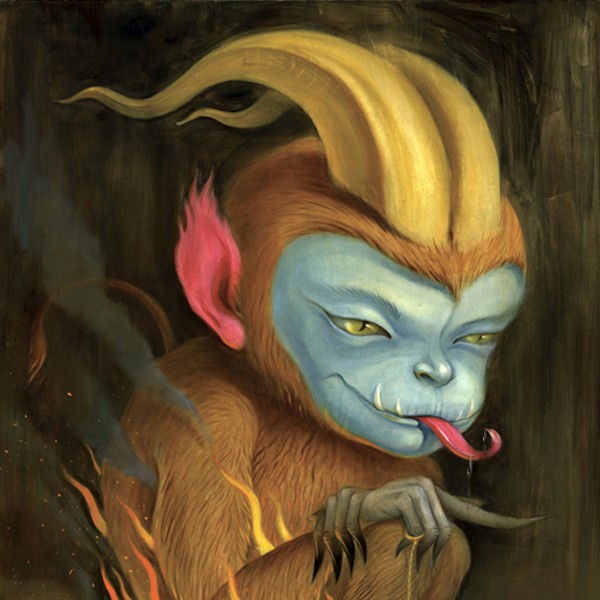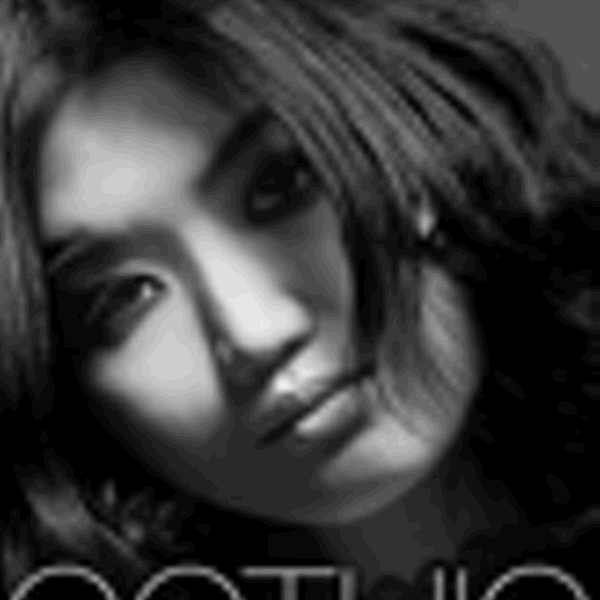"An agreeable kind of horror" was how the early 18th-century English man of letters Joseph Addison described the Alps. To Addison, the mountains were too massive and forbidding to be beautiful. Fifty years later, Edmund Burke furthered his countryman's notion in A Philosophical Inquiry into the Origin of Our Ideas of the Sublime and Beautiful (1756), delineating the dichotomy of beauty and this "agreeable kind of horror" (which Burke termed the sublime). The beautiful can fit in the palm of your hand and provides pleasure, an appreciation of aesthetic harmony. The sublime is more complex. It provides pleasure as well, but through the emotion of fear and attraction. Sublimity is the train wreck of aesthetics—you're terrified and yet you can't look away.
When encountering the odd, beasty-filled folk-arty paintings of Michael X. Rose, sublime is not the first word that comes to mind. In fact, a reasonable reaction to the man-eating dinosaurs, menacing ghosts, and nude women beset by crawly sea creatures might be: How on earth did this guy get a gallery show?
It's tough to know what to make of these paintings. Is it an elaborate joke? (Rose's press materials hint at this. Rose's bio includes apochryphal stories of his childhood, spent in the Sisters of Mercy Home for Boys in Newfoundland where he suffered "active discouragement from all pleasureable habits and repeated, prolonged physical abuse at the hands of older, stronger boys." Not to mention his direct descent from "Earl Hugh Rose, the last pirate publicly hanged in Charleston, South Carolina." When asked about the transparent fiction of his bio, Rose says that he was inspired by musician like David Bowie, who created alternate stage personas. "It seems funny to me that artists don't take stage names," Rose says. "Fine art is showbiz too.")
Rose, however, is in deadly earnest. An art-school grad who teaches art to Special Ed students, he doesn't seem to have an arch bone in his body. His work isn't some meta-commentary on the Death of Painting, it's just what he likes to paint. Monsters. Lots of them. Biting and clawing and bleeding and dying. Rose relates the story of being in a painting class and asking the teacher, "How many zombies do I add? Won't it get ridiculous?" The instructor, no doubt with a thought to the unbounded, unlimited quality of the sublime, told Rose to keep those zombies coming. "I'm always trying to add more," says Rose. "For instance, what if Moby Dick was wrapped in ropes and harpoons, and Ahab dead and tangled in the ropes, and the Pequod smahed on the shore? What if you had a painting that was so good, you could look at it for 15 years rather than 15 minutes?"
Rose is inspired by some obvious sources—the grand Romantic paintings of Gustave Moreau and Arnold Bocklin, filled with ruins and mythical and human drama, and Gothic horror novels (Rose recommends The Monk by Matthew Lewis)—and some atypical ones, like Shakespeare. "The mother dies, the stepfather dies, Ophelia dies, Hamlet dies, the play opens up with the father already dead," says Rose. "Everybody's dead. I wanted to apply that to painting."
"Realism for its own sake is boring," says Rose. "I only paint realistically so I can add a monster. And the monsters evoke the sublime—it has a bit of terror in it."
"The Crown of Creation," an exhibition of paintings by Michael X. Rose, will be displayed January 2 through January 31 at the Kingston Museum of Contemporary Art, 103 Abeel Street, Kingston. An opening reception will be held on Saturday, January 2, from 5 to 7pm. www.kmoca.org.

















